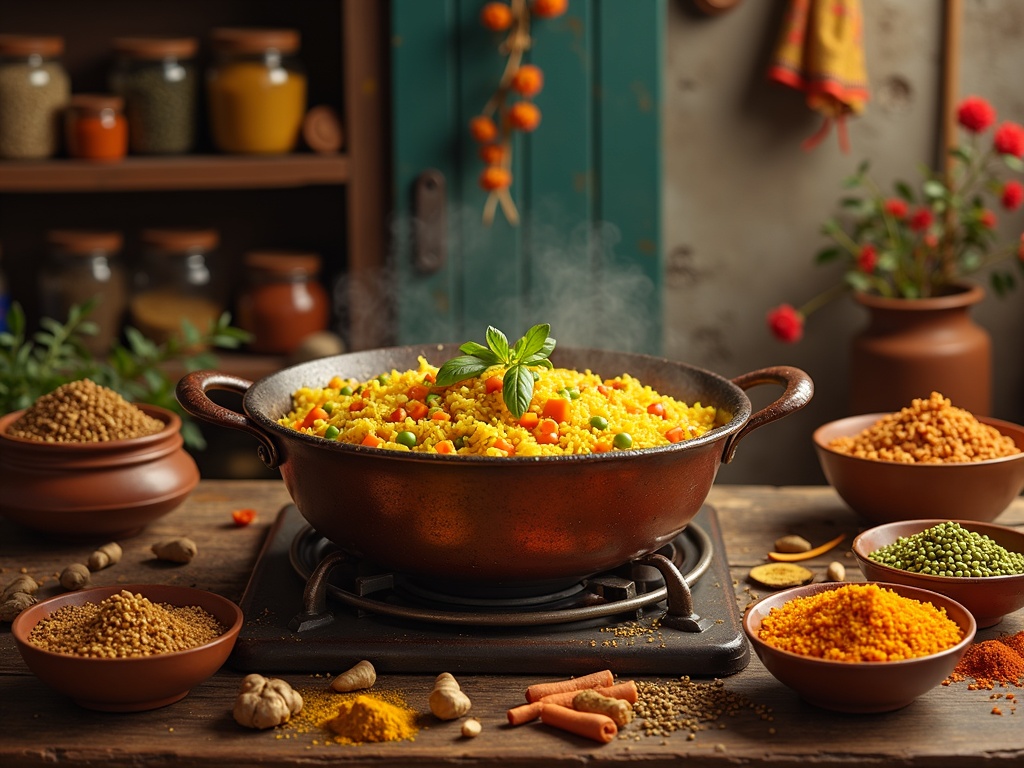Khichdi recipe, the quintessential Indian comfort food, combines rice and lentils into a nutritionally balanced one-pot meal that varies across regional boundaries throughout the subcontinent. This versatile dish serves multiple purposes—from being an easily digestible meal during illness to featuring prominently in cultural celebrations—while providing a complete protein source through its harmonized ingredients.
Find In This Article
Key Takeaways
- Khichdi offers the perfect balance of carbohydrates and protein, making it a complete nutritional powerhouse especially valuable for vegetarians.
- The dish is highly adaptable, with regional variations ranging from North Indian ghee-infused versions to South Indian coconut-flavored preparations.
- Traditional Ayurvedic medicine considers khichdi a sattvic (pure) food that balances all three doshas, making it an ideal healing meal.
- Basic khichdi requires simple ingredients—rice, lentils, ghee, and spices—but can be customized with vegetables and seasonings to enhance flavor and nutrition.
- Beyond its culinary significance, khichdi holds cultural importance in India, appearing in religious ceremonies and often serving as the first solid food introduced to infants.
Your Comfort Food Guide to Perfect Khichdi Recipe
Khichdi holds a special place in my heart as the ultimate Indian comfort food. This simple yet nourishing dish combines rice and lentils (typically moong dal) into a wholesome one-pot meal that’s become a staple across the Indian subcontinent. I’ve found that khichdi transcends regional boundaries, with each area adding its unique twist to this beloved classic.
The beauty of khichdi lies in its perfect balance of carbohydrates and protein, making it a complete nutritional powerhouse. When rice and lentils cook together, they create a combination of amino acids that provides your body with all the essential protein building blocks. This makes it particularly valuable for vegetarians looking for complete protein sources in their diet.
The Versatility of Khichdi Recipe
Khichdi’s adaptability is truly impressive. In North India, you’ll find it prepared with ghee and simple spices, while South Indian versions might incorporate coconut and different lentil varieties similar to curd rice preparations. The Bengali khichuri often includes vegetables and is served with fried treats, while Gujarati khichdi pairs perfectly with kadhi (a yogurt-based curry).
Here’s why khichdi has earned its reputation as the ultimate comfort food:
- Digestibility: The soft, mushy texture makes it incredibly easy to digest, perfect for when you’re feeling under the weather.
- Ayurvedic healing: Considered sattvic (pure) food in Ayurveda, believed to balance all three doshas.
- Customizable: Can be made plain for sensitive stomachs or spiced up with cumin, asafoetida, and ginger like jeera rice for more flavor.
- One-pot convenience: Everything cooks together, making it perfect for busy days.
- Vegetable-friendly: Carrots, peas, cauliflower, and potatoes can transform basic khichdi into a colorful, nutrient-dense meal.
What fascinates me about khichdi is its place in Indian cultural traditions. It’s often the first solid food introduced to infants, symbolizing its gentle nature. During religious fasts, many turn to sabudana khichdi made with tapioca pearls instead of rice. During illness, a simple khichdi offers nourishment without taxing the digestive system.
The cooking process itself is straightforward, making it accessible even to cooking novices. The basic technique involves rinsing rice and lentils, sautéing spices in ghee or oil (a process called tempering), adding the grains, and simmering until everything melds into a cohesive whole. The consistency can be adjusted from fairly dry and separate (like vegetable pulao) to porridge-like, depending on personal preference and regional traditions.
Modern variations have expanded khichdi’s repertoire. Millet khichdi substitutes rice with nutritious grains like bajra or jowar. Quinoa khichdi offers a protein-rich alternative for health-conscious eaters. Some creative cooks even prepare lemon-infused versions for a zesty twist.
I’ve discovered that the secret to exceptional khichdi lies in quality ingredients and proper technique. Using fresh spices, good quality ghee, and allowing the flavors to develop slowly transforms this humble dish into something truly special. A dollop of ghee on top before serving adds richness that complements the earthy flavors perfectly.
Whether prepared as a simple weeknight dinner, a healing meal during illness, or elevated with premium ingredients for guests, khichdi remains at heart what it has always been – nourishing, comforting food that satisfies both body and soul. Its simplicity belies its importance in Indian culinary tradition, where it stands as proof that the most basic combinations often yield the most profound satisfaction.
Nutritional Power Packed in Every Bowl
I’ve found khichdi to be one of the most balanced one-pot meals available. A standard 200g serving delivers approximately 240-300 calories, making it perfect for anyone monitoring their caloric intake while still wanting something satisfying and nourishing.
Complete Macronutrient Profile
Khichdi offers an impressive protein content of 10-12g per serving, with about half coming from the lentils. This makes it an excellent protein source for vegetarians looking to meet their daily requirements. The dish provides 40-45g of carbohydrates, offering sustained energy throughout the day rather than quick spikes and crashes.
What I particularly appreciate about khichdi is its fiber content—around 4-5g per serving—which supports digestive health and helps maintain feeling full longer. The fat content stays reasonably low at 2-5g, depending on how much ghee or oil is used during preparation.
Why Khichdi Recipe Stands Out Nutritionally
The nutritional value of khichdi stems from its perfect combination of ingredients:
- Rice provides essential carbohydrates for energy
- Lentils deliver plant-based protein and fiber
- Spices like turmeric and cumin add antioxidant properties
- Vegetables (when added) boost vitamin and mineral content
I often recommend khichdi as a complete meal because it closely resembles the ideal macronutrient distribution recommended by nutritionists. It’s especially beneficial for those recovering from illness, as it’s gentle on the stomach while still providing complete nutrition.
For those looking to boost the nutritional profile even further, adding a side of yogurt or curd introduces beneficial probiotics and additional protein. Vegetable-rich variations like mixed vegetable khichdi can increase the vitamin and mineral content substantially.
Many of my clients appreciate how khichdi can be customized based on specific dietary needs—adding more lentils increases protein content, while reducing rice and adding more vegetables lowers the carbohydrate count for those watching their carb intake.
When prepared with minimal oil and seasoned with healing spices, khichdi transforms from a simple comfort food into a therapeutic meal that nourishes both body and soul.
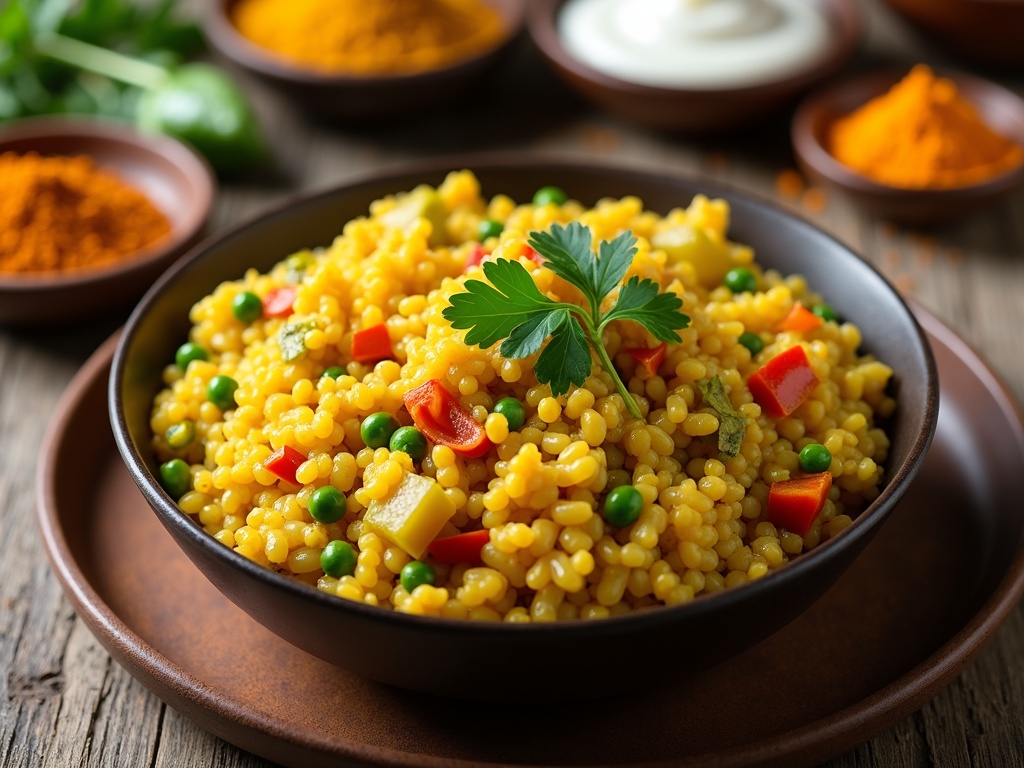
Essential Ingredients and Easy Preparation
Khichdi stands as one of the most comforting Indian dishes, combining simplicity with nourishment. I’ve found that gathering the right ingredients before starting makes the cooking process flow seamlessly.
Core Ingredients That Make Perfect Khichdi
The foundation of any good khichdi lies in its base ingredients:
- 1 cup Basmati rice (washed and soaked for 15-30 minutes)
- ½ cup yellow moong dal (rinsed thoroughly)
- 1 tablespoon ghee (clarified butter)
- 1 teaspoon cumin seeds
- Salt to taste
- 3-4 cups water (depending on desired consistency)
For added flavor and nutritional benefits, I often incorporate these optional ingredients:
- Mixed vegetables (carrots, peas, potatoes cut into small cubes)
- ½ teaspoon turmeric powder for that golden color
- 1-inch ginger piece, finely chopped
- 1-2 green chilies, slit lengthwise
- Fresh coriander leaves for garnishing
The beauty of traditional Indian rice dishes like khichdi is their versatility. You can adjust ingredients based on your preference or dietary needs.
I start my khichdi preparation by heating ghee in a pressure cooker. Once hot, I add cumin seeds and let them splutter. Next goes the ginger and green chilies (if using), followed by vegetables. After sautéing for a minute, I add the washed moong dal and rice. A gentle stir ensures everything gets coated with ghee and spices.
For the stovetop method, I add water, salt, and turmeric, then secure the pressure cooker lid. Cooking for 3-4 whistles on medium heat produces perfectly soft khichdi. After turning off the heat, I let the pressure release naturally before opening.
The Instant Pot method simplifies this process further. I use the same sequence of ingredients but set the pot to Manual/Pressure Cook for 15 minutes. A 10-minute natural pressure release results in khichdi with the ideal texture.
The consistency of khichdi can be adjusted according to preference. For a thicker version, similar to curd rice, use less water. If you prefer a soupy consistency, add more water after cooking.
I often serve khichdi with a dollop of ghee on top, accompanied by yogurt or papad. For added flavor, pair it with pickle or a simple potato curry. During illness, plain khichdi with minimal spices offers easy digestion and comfort.
What makes khichdi truly special is its adaptability. You can create variations like vegetable pulao style khichdi by adding more vegetables or transform it into a spicy masala khichdi by incorporating additional spices.
If you’re short on yellow moong dal, you can substitute other lentils like toor dal or masoor dal, though this will change the traditional flavor profile slightly. The essence of basmati rice dishes like khichdi lies in their ability to take on different character based on what you have available.
For leftovers, khichdi stays good in the refrigerator for 2-3 days. I typically add a splash of water when reheating to restore its original consistency.
This one-pot meal represents the perfect balance of taste, nutrition, and simplicity – making it a staple in many Indian households. Whether you’re looking for comfort food or a gentle meal during recovery, khichdi delivers both nourishment and satisfaction with minimal effort.
Regional Flavors Across India
India’s diverse culinary landscape has given rise to countless variations of khichdi, each region adding its unique twist to this comfort food. I’ve discovered that the beauty of khichdi lies in its adaptability across different states, with each version telling its own flavorful story.
Northern and Western Variations
The Gujarati style khichdi stands out with its distinctly sweet notes. This version often incorporates jaggery, giving it a mild sweetness that perfectly balances the savory elements. Gujaratis typically serve their khichdi with kadhi, a yogurt-based curry that complements the dish beautifully. The combination creates a perfect harmony of flavors that’s both comforting and satisfying.
Moving to Punjab, the khichdi takes on a bolder personality. Punjabi khichdi packs a spicier punch with generous use of whole spices and chili. This heartier version is commonly served with tangy pickles and cooling raita. The contrast between the spicy khichdi and the soothing raita creates a delightful taste experience that’s characteristic of Punjabi cuisine. For a complete meal similar to this style, you might also enjoy creamy dal makhani which shares the same robust flavor profile.
Eastern Delights and Serving Traditions
The Bengali variation of khichdi, often called bhoger khichuri, has its own distinctive character. This version typically includes an assortment of mixed vegetables and is cooked with aromatic mustard oil. The Bengali khichdi is frequently prepared during religious festivals and has a slightly wetter consistency compared to other regional versions. Similar to vegetable pulao, it transforms simple ingredients into something truly special.
When serving khichdi, I’ve found these accompaniments enhance the experience:
- Fresh yogurt or raita to add creaminess and cool down spicier versions
- Assorted pickles that add tang and heat
- Crispy papads for textural contrast
- Ghee-roasted cumin for aromatic garnish
- A side of curd rice for those who enjoy varied textures in their meal
The regional variations don’t end here – from the coconut-infused khichdi of Kerala to the dry, separate-grained khichdi of Rajasthan, this dish continues to evolve across India’s diverse geography. Much like lemon rice in South India, khichdi serves as both everyday fare and festival food, adapting to the occasion with subtle changes in ingredients and preparation methods.
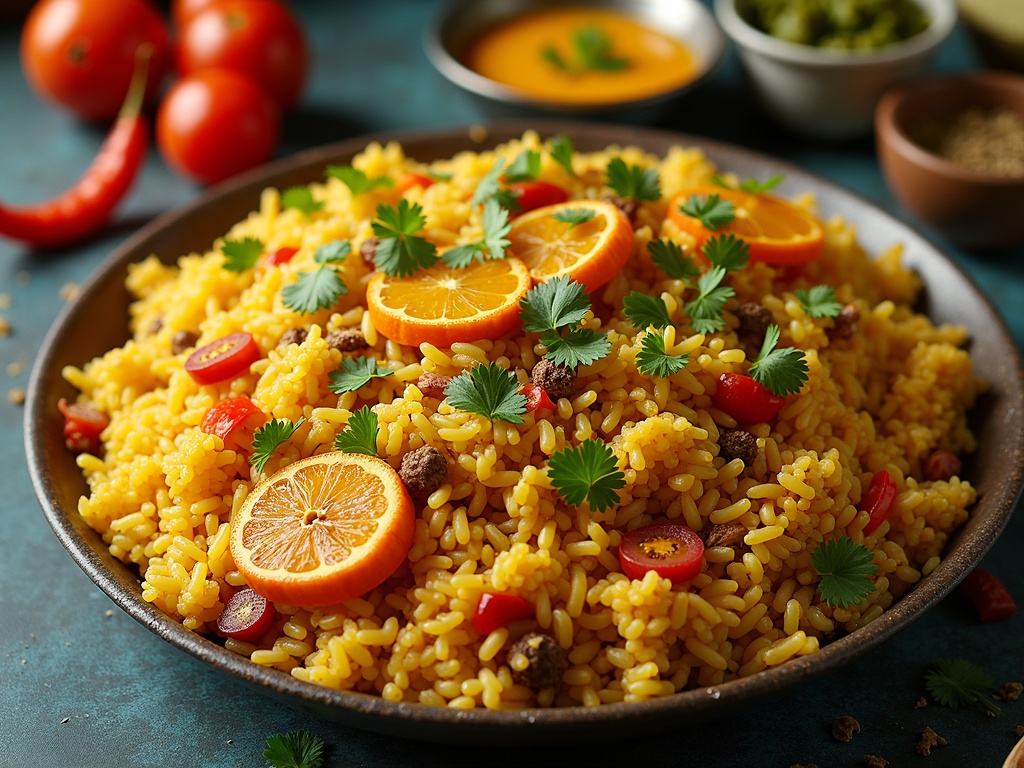
Health Benefits and Ayurvedic Significance
Khichdi stands out as a powerhouse of nutrition in Indian cuisine. I’ve found that this simple one-pot meal offers remarkable health benefits that extend far beyond just satisfying hunger. The combination of rice and lentils creates a complete protein profile that’s gentle on the stomach while providing sustained energy throughout the day.
Nutritional Powerhouse for Wellbeing
The fiber content in khichdi is particularly impressive. The combination of rice and lentils delivers a substantial amount of dietary fiber that helps improve digestion and promotes gut health. I’ve noticed that eating khichdi regularly can help maintain digestive regularity and prevent common gastrointestinal issues.
For those watching their weight, khichdi offers an ideal meal option. It’s naturally low in calories yet provides a satisfying fullness due to its protein and fiber content. The balanced nutrition in khichdi makes it perfect for weight management without feeling deprived. I particularly appreciate how lentil-based dishes like khichdi can be both filling and figure-friendly.
People with dietary restrictions will find khichdi especially valuable. It’s naturally:
- Gluten-free, making it suitable for those with celiac disease or gluten sensitivity
- Easy to digest, ideal for recovering from illness or digestive upset
- Customizable for various health needs by adjusting ingredients
- Free from common allergens when prepared in its basic form
The gentle nature of khichdi makes it particularly beneficial during illness. I’ve relied on it countless times when recovering from stomach bugs or feeling under the weather. The soft texture requires minimal digestive effort while still providing crucial nutrients when the body needs them most.
Khichdi also holds special significance in Ayurveda, the ancient Indian medical system. In Ayurvedic practice, khichdi is considered a sattvic food – one that promotes clarity, balance, and purity in the body and mind. It’s prescribed for balancing all three doshas (vata, pitta, and kapha), making it a universal healing food.
Many Ayurvedic practitioners recommend khichdi for detoxification programs. The simplicity of its ingredients allows the digestive system to rest while still receiving essential nutrition. During seasonal transitions or after periods of dietary indulgence, a khichdi cleanse can help reset the digestive system.
The basmati rice typically used in authentic rice dishes like khichdi has a low glycemic index compared to other rice varieties, making it suitable for managing blood sugar levels. When combined with protein-rich lentils, the overall meal provides stable energy without sharp blood sugar spikes.
The tempering spices used in khichdi – cumin, turmeric, and ginger – add more than just flavor. Turmeric contains curcumin, a compound with powerful anti-inflammatory properties. Cumin aids digestion and improves nutrient absorption. Ginger soothes the digestive tract and reduces inflammation.
For those looking to incorporate more plant-based meals into their diet, khichdi offers an excellent entry point. It provides complete protein through the combination of grains and legumes, similar to how vegetable pulao creates nutritional balance through its diverse ingredients.
The versatility of khichdi means you can easily enhance its nutritional profile by adding seasonal vegetables, making it an even more nutrient-dense meal option that supports overall health and wellbeing.
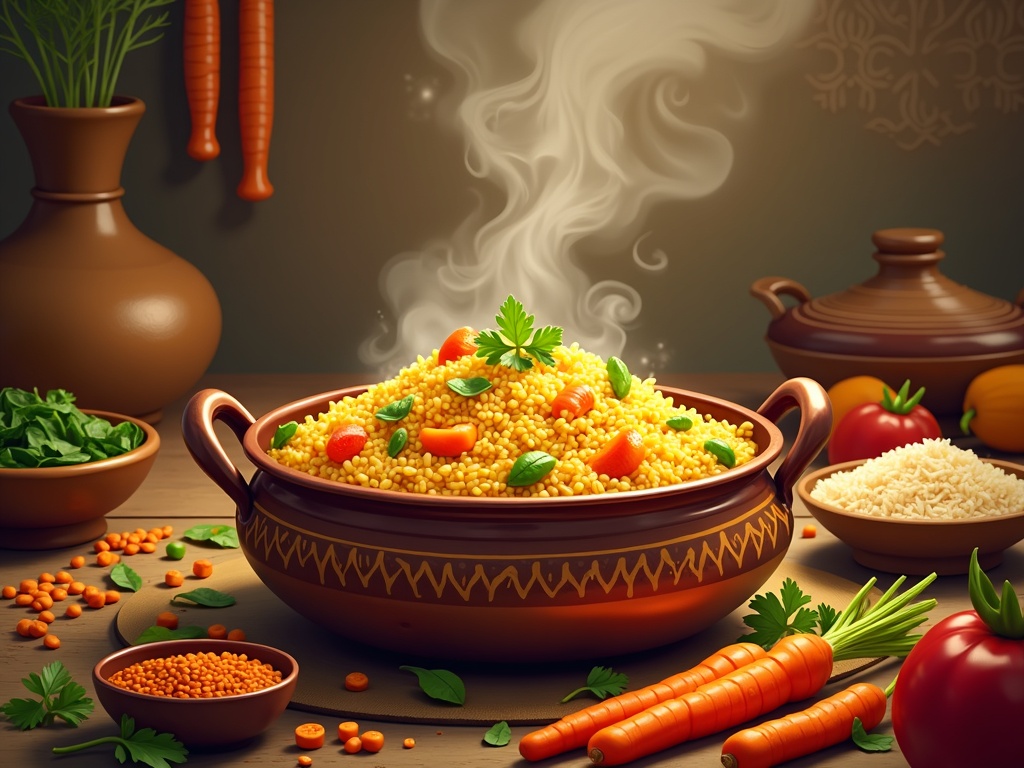
Cultural Importance and Traditions
Khichdi holds a special place in Indian culture that goes far beyond its simple ingredients. I’ve found that this humble dish appears at some of the most significant moments in people’s lives across the subcontinent. Its cultural footprint stretches from celebratory feasts to healing meals, making it one of India’s most versatile culinary creations.
Festival Connections
Khichdi takes center stage during several important Indian festivals, with Makar Sankranti being particularly noteworthy. This harvest festival, celebrated in January, traditionally features khichdi as the main offering. I’ve seen families gather to prepare massive batches of this rice and lentil dish, often sweetened slightly to symbolize the sweetness they hope will enter their lives in the coming year.
The connection between khichdi and festivals extends to other celebrations as well:
- During Navratri, a simpler version serves as an easily digestible meal for those fasting.
- In Bengal, the dish (known as khichuri) becomes an essential offering to Goddess Durga.
- Many rural communities prepare communal khichdi during harvest celebrations as a thanksgiving meal.
- In Gujarat, Uttarayan celebrations include flavorful versions of khichdi shared with neighbors and family.
Ayurvedic Foundations
The reverence for khichdi goes deeper than tradition—it’s backed by ancient wisdom. Ayurveda, India’s traditional medical system, considers khichdi a perfectly balanced food. I’ve learned that Ayurvedic practitioners recommend it because it balances all three doshas (the body’s energy types).
When illness strikes, khichdi becomes the go-to prescription across countless Indian households. The dish offers easy digestion while providing complete protein through the combination of rice and lentils. This balance makes it ideal for those recovering from illness or digestive distress.
The cultural significance of khichdi as healing food explains why so many Indians associate it with maternal care. Much like chicken soup in Western cultures, a warm bowl of khichdi with soft lentils represents comfort and recovery.
Across generations, khichdi has maintained its status as India’s ultimate comfort food. Regional variations abound—from the spicy Hyderabadi khichdi to the sweet Bengali version and the hearty Punjabi style—but the emotional connection remains consistent. I’ve noticed that regardless of whether it’s made with creamy rice or mixed with tangy flavors, khichdi evokes memories of home.
This dish transcends regional and religious boundaries, appearing on tables in Muslim homes as much as Hindu ones, in wealthy households and modest ones alike. Its universality reflects India’s unity through food culture. The widespread appeal comes from its adaptability—khichdi can be incredibly simple or surprisingly complex, making it appropriate for both everyday meals and special occasions.
What fascinates me most is how khichdi represents core Indian values: simplicity, balance, and nourishment without excess. Whether served with ghee and pickle during a festival or plain during illness, it connects people to their roots and each other. This dish, similar to upma or jeera rice but uniquely versatile, serves as a cultural touchstone that continues to unite people across geography and generations.
As India modernizes rapidly, khichdi remains relevant—a reminder that sometimes the most meaningful traditions center around the simplest things. Its enduring place on Indian tables speaks to how deeply embedded it is in the cultural consciousness of the nation.
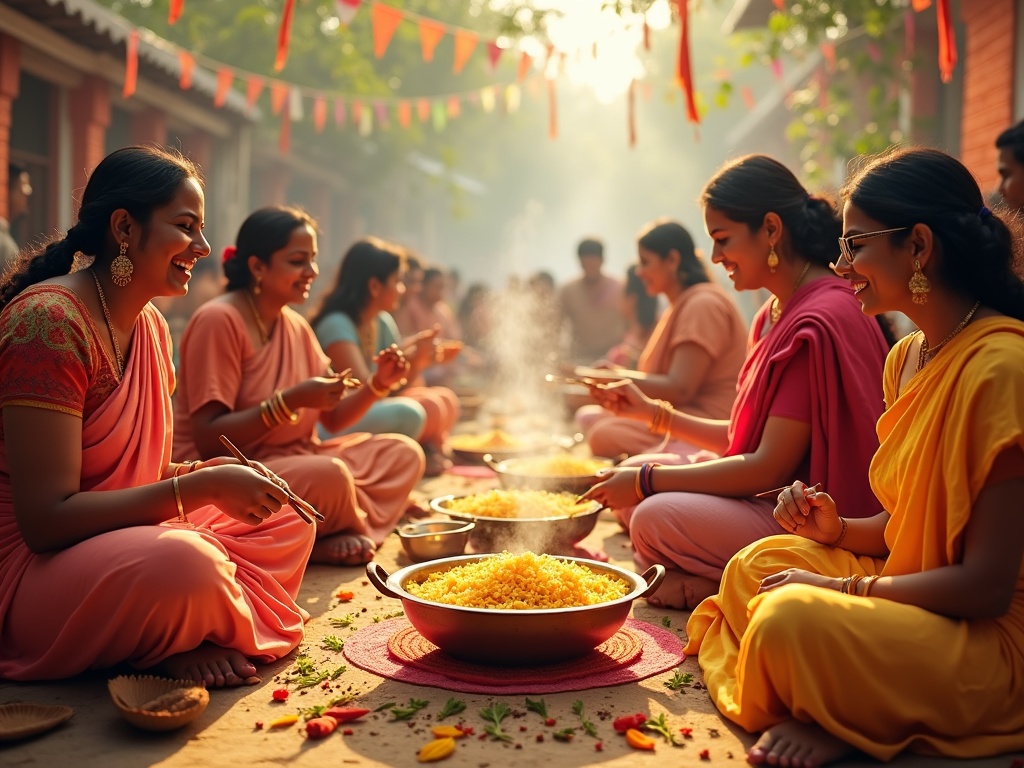
Sources:
The Complete Book of Indian Cooking by Julie Sahni
What’s Cooking? A Guide to Indian Cuisine by Sanjeev Kapoor
Indian Superfoods by Rujuta Diwekar
Journal of Culinary Nutrition

